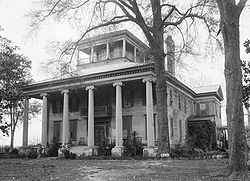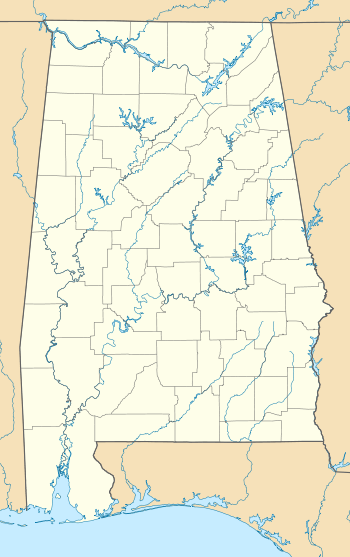Rosemount (Forkland, Alabama)
|
Rosemount | |
 | |
|
The front (south) elevation of Rosemount in 1934 | |
 | |
| Nearest city | Forkland, Alabama |
|---|---|
| Coordinates | 32°40′16″N 87°54′28″W / 32.67111°N 87.90778°WCoordinates: 32°40′16″N 87°54′28″W / 32.67111°N 87.90778°W |
| Built | 1832-50s |
| Architect | Allen Glover |
| Architectural style | Greek Revival |
| Governing body | Private |
| NRHP Reference # | 71000099[1] |
| Added to NRHP | May 27, 1971 |
Rosemount is a historic plantation house near Forkland, Alabama. The Greek Revival style house was built in stages between 1832 and the 1850s by the Glover family. The house has been called the "Grand Mansion of Alabama."[2][3] The property was added to the National Register of Historic Places on May 27, 1971.[1]
History
Allen Glover, of Demopolis, gave the 3,000-acre (1,200 ha) property, along with the beginnings of the main house, to his son, Williamson Allen Glover, in the early 1830s. The house was centered on a prominent star-shaped hill. Williamson Allen Glover expanded the house through successive additions and reconfigurations.[2] He went on to raise a total of sixteen children in the mansion's twenty rooms.
Architecture
The exterior of the house features a Carolina-type monumental two-story Ionic portico, east and west side porches, and a continuous cornice with dentils above the second story and the cupola. The house plan forms a T-shape, to take advantage of the cross-ventilation that this plan affords.[4] The major interior rooms include an entrance hall, twin parlors, great halls on both main floors that are 60 feet (18 m) long, a dining room, eight bedrooms, and a roof-top cupola, the largest residential example in Alabama.[5] The cupola houses a music room that measures 16 feet (4.9 m) by 25 feet (7.6 m), double doors exit the south side of the music room onto a three sided porch with Doric columns. The cupola functioned as a look-out over the plantation and, along with the great halls, as a way to exhaust heated air out of the house during hot weather.[6] Though no longer extant, the grounds once included formal gardens, a carriage house, a two-story servant's quarters, a schoolhouse, several barns, a corn crib, a shop, five slave cabins behind the main house, and a "slave village" about one mile away. Additionally there was a detached kitchen, now destroyed, that was later moved and attached to the house.[4]
The house passed through different families over the years, going through some periods of disrepair and later, restorations. A massive restoration was begun around 2005 and the exterior was completely finished. The mansion has remained empty since and is slowly being overtaken by vegetation.
See also
- Glover Mausoleum, built for Williamson Glover's father and also listed on the NRHP
References
| Wikimedia Commons has media related to Rosemount Plantation. |
- ↑ 1.0 1.1 "National Register Information System". National Register of Historic Places. National Park Service. 2008-04-15.
- ↑ 2.0 2.1 Hammond, Ralph (1951). Ante-bellum mansions of Alabama. New York: Architectural Book Company. pp. 104–105. ISBN 0-517-02075-0.
- ↑ Brown, Virginia Pounds; Akens, Helen Morgan (1967). Alabama heritage. Huntsville, Alabama: Strode Publishers. p. 114.
- ↑ 4.0 4.1 "Rosemount, County Road 19, Forkland vicinity, Greene County, AL". Historic American Buildings Survey. 14 February 1936. Retrieved 30 November 2008.
- ↑ Gamble, Robert (1990). Historic architecture in Alabama: a guide to styles and types, 1810-1930. Tuscaloosa, Alabama: University of Alabama Press. p. 61. ISBN 0-8173-1134-3.
- ↑ Lane, Mills; Van Jones Martin (1989). Architecture of the Old South : Mississippi and Alabama. New York: Abbeville Press. pp. 106–107. ISBN 1-55859-008-0.
| ||||||||||||||||||||||||||